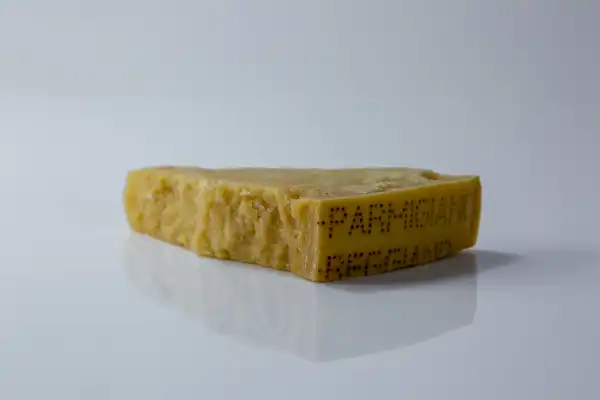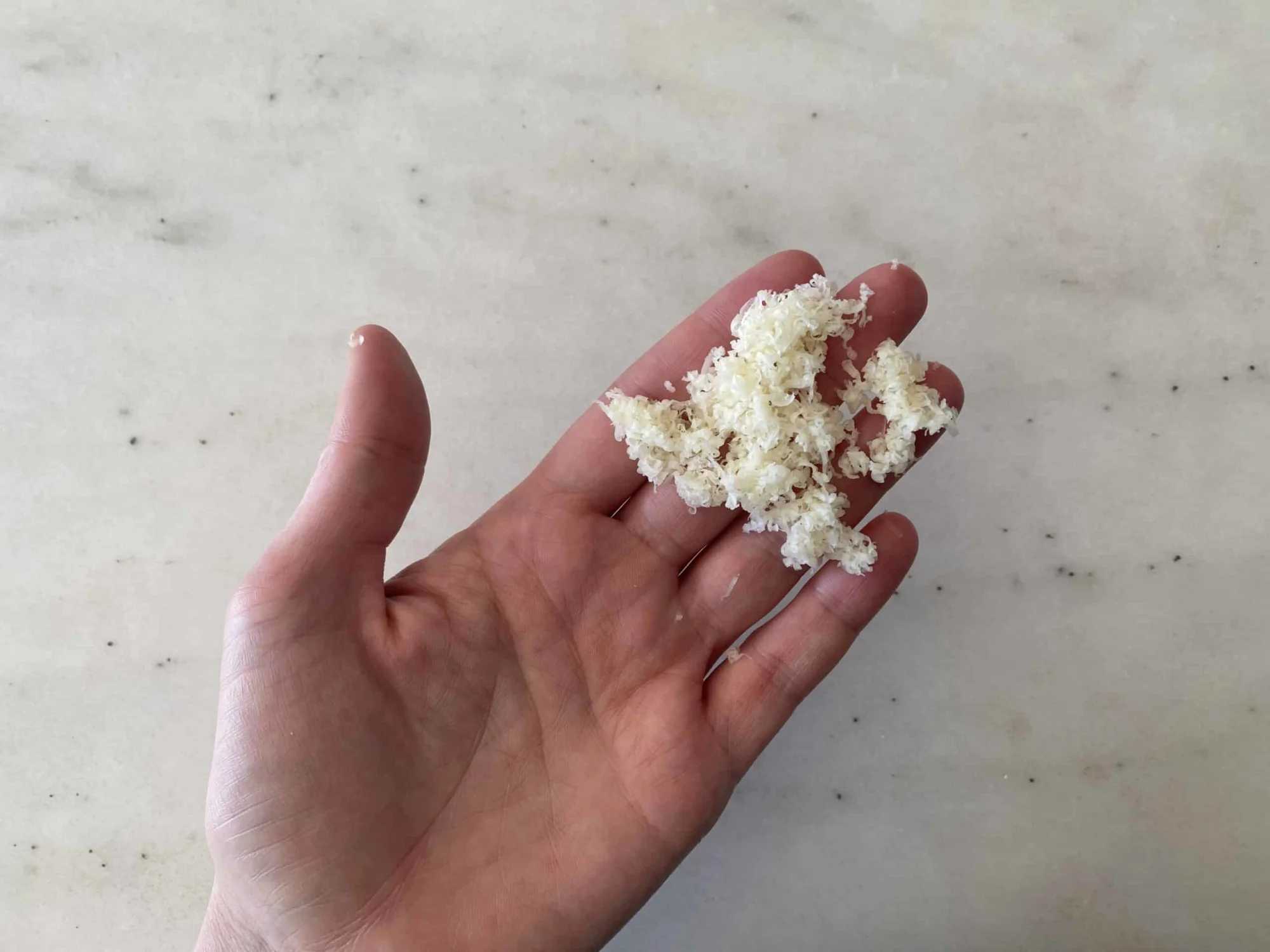Parmesan
Dairy
Age Suggestion
12 months
Iron-Rich
No
Common Allergen
Yes

When can babies eat parmesan cheese?
Parmesan cheese is best served in small amounts after baby’s first birthday due to its higher sodium levels. However, a sprinkle here and there for younger babies is fine.
In general, the best cheeses for babies younger than 12 months old are pasteurized and low in sodium, including emmentaler cheese, fresh goat cheese, labneh, mascarpone cheese, fresh mozzarella cheese, paneer, fresh ricotta cheese, and swiss cheese.
Where does parmesan come from?
Parmesan is part of the grana family of cheeses, which are hard, grating cheeses with origins in Italy. While parmesan is made worldwide, it is not the same as Parmigiano Reggiano, which is fiercely protected by an Italian regulation called Protected Designation of Origin. The law requires any cheese stamped with the Parmigiano Reggiano label to have been made from the milk of cows grazing in the fields of the Bologna, Mantua, Modena, or Parma regions, where the cheese is traditionally shaped into large wheels that are brined and aged. During the aging process, both parmesan and Parmigiano Reggiano develop a thick rind, which can be used to imbue stocks, soups, and stews with umami flavor.
Videos
Is parmesan healthy for babies?
No. Parmesan (including the powdered kind often sold in plastic shakers) is high in sodium, which should be limited in infant diets. That said, a small sprinkle of pasteurized parmesan cheese is fine. Parmesan cheese is often made from unpasteurized (raw) milk. In general, unpasteurized cheeses carry a higher risk of foodborne illness, but those aged for more than 60 days – like parmesan – pose a lower risk. Read our cheese page for more information and consider the risk in the context of your individual child.
Nutritionally, parmesan cheese contains healthy fats and protein and is also rich in calcium, vitamin B12, plus selenium and zinc.
Is parmesan a common choking hazard for babies?
Yes, it can be if served in chunks or melted globs. Cheese is a common choking hazard for babies and children. To minimize the risk, grate parmesan or slice parmesan blocks thinly and avoid serving in cubes or large crumbles. As always, make sure you create a safe eating environment and stay within arm’s reach of baby during meals. For more information on choking, visit our section on gagging and choking and familiarize yourself with the list of common choking hazards.
Is parmesan a common allergen?
Yes. Parmesan cheese is made from cow’s milk, and cow’s milk is a common food allergen in young children, accounting for about one-fifth of all childhood food allergies in the United States. Keep in mind that cheeses made from other ruminants such as sheep, goat, and buffalo may provoke similar allergic reactions to cow’s milk dairy products. That said, there’s good news: milk allergy often disappears with time. Research shows that the majority of children with cow's milk allergy will outgrow it by age 6 and many babies with milder symptoms of milk protein allergy (which can show up as painless blood in stool) are able to successfully reintroduce cow's milk as early as their first birthday, with the guidance of their doctors. Note: Aged cheeses generally contain histamines, which may cause rashes in children who are sensitive to them.
Milk is a known trigger of food protein-induced enterocolitis syndrome, also known as FPIES. FPIES is a delayed allergy to food protein which causes the sudden onset of repetitive vomiting and diarrhea to begin a few hours after ingestion. Left untreated, the reaction can result in significant dehydration. Thankfully, like other forms of milk allergy, FPIES which presents early in life is generally outgrown by the time the child has reached 3-5 years of age. While the exact rates of FPIES are unknown, it is believed to be an uncommon condition (although better recognition of the disease has led to increased reporting in recent years).
Although it is not an allergy, lactose intolerance can result in gastrointestinal symptoms, such as abdominal pain, bloating, and diarrhea, after ingestion of dairy items containing lactose. For those with older children who are lactose intolerant (keep in mind this is uncommon for infants and toddlers), some good news: compared with milk and certain other dairy products, many cheeses may be better tolerated by those with lactose intolerance, particularly aged cheeses, which have lower lactose content. Note that if your child is lactose-intolerant, it’s important to find calcium-rich foods to consume regularly to ensure a balanced diet and support bone health. Search for naturally low-lactose cheeses and dairy products labeled “lactose-free.”
If you suspect baby may be allergic to milk, consult an allergist before introducing dairy products like cheese. Based on baby’s risk factors and history, your allergist may recommend allergy testing, or may instead advise dairy introduction under medical supervision in the office. If the risk is low, you may be advised to go ahead and introduce dairy in the home setting. As with all common allergens, start by serving a small quantity on its own for the first few servings, and if there is no adverse reaction, gradually increase the quantity over future meals.
Recommended Guide: Introducing Allergens
How do you prepare parmesan for babies with baby-led weaning?
Every baby develops on their own timeline, and the suggestions on how to cut or prepare particular foods are generalizations for a broad audience.
6 to 12 months old:
Hold off on serving parmesan cheese due to sodium content and opt for a low-sodium cheese or a vegan substitute like nutritional yeast. If you happen to have a dish with parmesan already prepared for yourself and you’d like to share, feel free to do so—a small sprinkle of parmesan here and there is fine.
12 to 24 months old:
Serve small amounts of grated or finely shredded parmesan, in moderation. When offering it on its own from a block, cut parmesan into small, bite-sized pieces cut from a thin slice of cheese. Avoid serving parmesan in cubes or large crumbles, as these present a high choking risk.


Not sure how much sodium baby can have? See our Sodium page.
Written by
Expert Tips Delivered to Your Inbox
Sign up for weekly tips, recipes and more!
The content offered on SolidStarts.com is for informational purposes only. Solidstarts is not engaged in rendering professional advice, whether medical or otherwise, to individual users or their children or families. No content on this site, regardless of date, should ever be used as a substitute for direct medical advice from your doctor or your medical or health professional, nutritionist, or expert in pediatric feeding and eating. By accessing the content on SolidStarts.com, you acknowledge and agree that you are accepting the responsibility for your child’s health and well-being. In return for providing you with an array of content “baby-led weaning” information, you waive any claims that you or your child may have as a result of utilizing the content on SolidStarts.com.








